NCERT Solutions for Class 9 Science 11 : Sound
In Class 9 Science Chapter 11 “Sound,” students delve into the study of vibration waves in a medium (like air) as well as their characteristics. This chapter presents basics needed for understanding how sounds are produced, transmitted and perceived by people.
Download PDF For NCERT Solutions for Science Sound
The NCERT Solutions for Class 9 Science 11 : Sound are tailored to help the students master the concepts that are key to success in their classrooms. The solutions given in the PDF are developed by experts and correlate with the CBSE syllabus of 2023-2024. These solutions provide thorough explanations with a step-by-step approach to solving problems. Students can easily get a hold of the subject and learn the basics with a deeper understanding. Additionally, they can practice better, be confident, and perform well in their examinations with the support of this PDF.
Download PDF
Access Answers to NCERT Solutions for Class 9 Science 11 : Sound
Students can access the NCERT Solutions for Class 9 Science 11 : Sound. Curated by experts according to the CBSE syllabus for 2023–2024, these step-by-step solutions make Science much easier to understand and learn for the students. These solutions can be used in practice by students to attain skills in solving problems, reinforce important learning objectives, and be well-prepared for tests.
Sound
What is reverberation? How can it be reduced?
The continuous multiple reflections of sound in a big enclosed space are reverberation. It can be reduced by covering walls and ceilings of enclosed spaces with the help of sound-absorbing materials, such as loose woollens and fibre boards.
What is the loudness of sound? What factors does it depend on?
Loud sounds have high energy. Loudness directly depends on the amplitude of vibrations. It is proportional to the square of the amplitude of vibrations of sound.
Explain how bats use ultrasound to catch prey.
Bats have the ability to produce high-pitched ultrasonic squeaks. These squeaks get reflected by objects, like prey, and return to their ears. This helps a bat to know how far its prey is.
How is ultrasound used for cleaning?
Objects that need to be cleansed are put in a cleaning solution, and ultrasonic sound waves are passed through the solution. The high frequency of ultrasound waves helps in detaching the dirt from the objects. In this way, ultrasound is used for cleaning purposes.
Does sound follow the same laws of reflection as light does? Explain.
Yes. Sound follows the same laws of reflection as light. The reflected sound wave and the incident sound wave make an equal angle with the normal to the surface at the point of incidence. Also, the reflected sound wave, the normal to the point of incidence, and the incident sound wave all lie in the same plane.
How does the sound produced by a vibrating object in a medium reach your ear?
When an object vibrates, it necessitates the surrounding particles of the medium to vibrate. The particles that are adjacent to vibrating particles are forced to vibrate. Hence, the sound produced by a vibrating object in a medium is transferred from particle to particle till it reaches your ear.
Explain how sound is produced by your school bell.
When the school bell is hit with a hammer, it moves forward and backwards, producing compression and rarefaction due to vibrations. This is how sound is produced by the school bell.
Why are sound waves called mechanical waves?
Sound waves require a medium to propagate to interact with the particles present in them. Therefore, sound waves are called mechanical waves.
Suppose you and your friend are on the moon. Will you be able to hear any sound produced by your friend?
No. Sound waves require a medium to propagate. Due to the absence of an atmosphere on the moon and since sound cannot travel in a vacuum, I will not be able to hear any sound produced by my friend.
Which wave property determines (a) loudness, (b) pitch?
(a) Amplitude – The loudness of the sound and its amplitude is directly related to each other. The larger the amplitude, the louder the sound.
(b) Frequency – The pitch of the sound and its frequency is directly related to each other. If the pitch is high, then the frequency of sound is also high.
Guess which sound has a higher pitch: guitar or car horn?
The pitch of a sound is directly proportional to its frequency. Therefore, the guitar has a higher pitch when compared to a car horn.
How are the wavelength and frequency of a sound wave related to its speed?
Wavelength, speed, and frequency are related in the following way:
Speed = Wavelength x Frequency
v = λ ν
Distinguish between loudness and intensity of sound.
The amount of sound energy passing through an area every second is called the intensity of a sound wave. Loudness is defined by its amplitude.
In which of the three media, air, water or iron, does sound travel the fastest at a particular temperature?
Sound travels faster in solids when compared to any other medium. Therefore, at a particular temperature, sound travels fastest in iron and slowest in gas.
Why are the ceilings of concert halls curved?
The ceilings of concert halls are curved to spread sound uniformly in all directions after reflecting from the walls.
What is the audible range of the average human ear?
20 Hz to 20,000 Hz. Any sound less than 20 Hz or greater than 20,000 Hz frequency is not audible to human ears.
What is the range of frequencies associated with (a) Infrasound? (b) Ultrasound?
(a) 20 Hz
(b) 20,000 Hz
What is sound, and how is it produced?
Sound is produced due to vibrations. When a body vibrates, it forces the adjacent particles of the medium to vibrate. This results in a disturbance in the medium, which travels as waves and reaches the ear. Hence, the sound is produced.
Why is a sound wave called a longitudinal wave?
The vibration of the medium that travels parallel to the direction of the wave or along in the direction of the wave is called a longitudinal wave. The direction of particles of the medium vibrates parallel to the direction of the propagation of disturbance. Therefore, a sound wave is called a longitudinal wave.
What are the wavelength, frequency, time period and amplitude of a sound wave?
(a) Wavelength – Wavelength can be defined as the distance between two consecutive rarefactions or two consecutive compressions. The SI unit of wavelength is metre (m).
(b) Frequency – Frequency is defined as the number of oscillations per second. The SI unit of frequency is hertz (Hz).
(c) Amplitude – Amplitude can be defined as the maximum height reached by the trough or crest of a sound wave.
(d) Time period – The time period is defined as the time required to produce one complete cycle of a sound wave.
Calculate the wavelength of a sound wave whose frequency is 220 Hz and speed is 440 m/s in a given medium.
Given that,
Frequency of sound wave = 220 Hz
Speed of sound wave = 440 m/s
Calculate wavelength.
We know that
Speed = Wavelength × Frequency
v = λ ν
440 = Wavelength × 220
Wavelength = 440/220
Wavelength = 2
Therefore, the wavelength of the sound wave = 2 metres
A person is listening to a tone of 500 Hz, sitting at a distance of 450 m from the source of the sound. What is the time interval between successive compressions from the source?
The time interval between successive compressions from the source is equal to the time period, and the time period is reciprocal to the frequency. Therefore, it can be calculated as follows:
T= 1/F
T= 1/500
T = 0.002 s
An echo is heard in 3 s. What is the distance of the reflecting surface from the source, given that the speed of sound is 342 ms-1?
Speed of sound (v) = 342 ms-1
Echo returns in time (t) = 3 s
Distance travelled by sound = v × t = 342 × 3 = 1026 m
In the given interval of time, sound must travel a distance which is twice the distance between the reflecting surface and the source.
Therefore, the distance of the reflecting surface from the source =1026/2 = 513 m
A submarine emits a sonar pulse, which returns from an underwater cliff in 1.02 s. If the speed of sound in salt water is 1531 m/s, how far away is the cliff?
Time (t) taken by the sonar pulse to return = 1.02 s
Speed (v) of sound in salt water = 1531 m s-1
Distance travelled by sonar pulse = Speed of sound × Time taken
= 1531 x 1.02 = 1561.62 m
Distance of the cliff from the submarine = (Total distance travelled by sonar pulse) / 2
= 1561.62 / 2
= 780.81 m.
Which characteristics of the sound help you to identify your friend by his voice while sitting with others in a dark room?
Quality of sound is a characteristic that helps us identify the voice of a particular person. Two people may have the same pitch and loudness, but their qualities will be different.
Give two practical applications of the reflection of sound waves.
(i) Reflection of sound is used to measure the speed and distance of underwater objects. This method is called SONAR.
(ii) Working of a stethoscope – The sound of a patient’s heartbeat reaches the doctor’s ear through multiple reflections of sound.
Describe, with the help of a diagram, how compressions and rarefactions are produced in the air near a source of the sound.
When the school bell is hit with a hammer, it moves forward and backwards, producing compression and rarefaction due to vibrations. When it moves forward, it creates high pressure in its surrounding area. This high-pressure region is known as compression. When it moves backwards, it creates a low-pressure region in its surrounding. This region is called rarefaction.
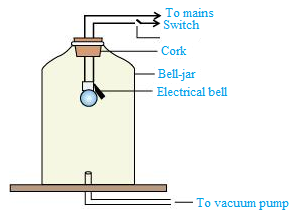
Cite an experiment to show that sound needs a material medium for its propagation.
Take an electric bell and hang it inside an empty bell jar which is fitted with a vacuum pump (as shown in the figure below).
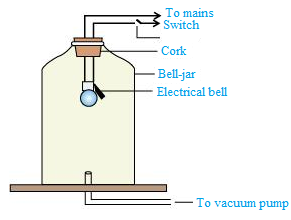
Initially, one can hear the sound of the ringing bell. Now, pump out some air from the bell jar using the vacuum pump. You will realise that the sound of the ringing bell decreases. If you keep on pumping the air out of the bell jar, then the glass jar will be devoid of any air after some time. Now, try to ring the bell. No sound is heard, but you can see the bell prong is still vibrating. When there is no air present in the bell jar, a vacuum is produced. Sound cannot travel through a vacuum. Therefore, this experiment shows that sound needs a material medium for its propagation.
Flash and thunder are produced simultaneously. But thunder is heard a few seconds after the flash is seen. Why?
The speed of sound is 344 m/s, whereas the speed of light is 3 × 108 m/s. The speed of light is less when compared to that of light. Due to this reason, thunder takes more time to reach the Earth as compared to light speed, which is faster. Hence, lightning is seen before whenever we hear thunder.
A person has a hearing range from 20 Hz to 20 kHz. What are the typical wavelengths of sound waves in air corresponding to these two frequencies? Take the speed of sound in air as 344 m s−1.
For sound waves,
Speed = Wavelength × frequency
v = λ × v
Speed of sound wave in air = 344 m/s
(a) For v = 20 Hz
λ1 = v/v1 = 344/20 = 17.2 m
(b) For v2 = 20,000 Hz
λ2 = v/v2 = 344/20,000 = 0.0172 m
Therefore, for human beings, the hearing wavelength is in the range of 0.0172 m to 17.2 m.
Two children are at opposite ends of an aluminium rod. One strikes the end of the rod with a stone. Find the ratio of times taken by the sound wave in the air and in aluminium to reach the second child.
Consider the length of the aluminium rod = d
Speed of sound wave at 25° C, V Al = 6420 ms-1
Time taken to reach the other end is,
T Al = d/ (V Al) = d/6420
Speed of sound in air, V air = 346 ms-1
Time taken by sound to each other end is,
T air = d/ (V air) = d/346
Therefore, the ratio of time taken by sound in aluminium and air is,
T air / t Al = 6420 / 346 = 18.55
The frequency of a source of sound is 100 Hz. How many times does it vibrate in a minute?
Frequency = (Number of oscillations) / Total time
Number of oscillations = Frequency × Total time
Given,
Frequency of sound = 100 Hz
Total time = 1 min (1 min = 60 s)
Number of oscillations or vibrations = 100 × 60 = 6000
The source vibrates 6000 times in a minute and produces a frequency of 100 Hz.
When a sound is reflected from a distant object, an echo is produced. Let the distance between the reflecting surface and the source of sound production remains the same. Do you hear an echo sound on a hotter day?
An echo is heard when the time interval between the reflected sound and the original sound is at least 0.1 seconds. As the temperature increases, the speed of sound in a medium also increases. On a hotter day, the time interval between the reflected and original sound will decrease, and an echo is audible only if the time interval between the reflected sound and the original sound is greater than 0.1 s.
A stone is dropped from the top of a tower 500 m high into a pond of water at the base of the tower. When is the splash heard at the top? Given, g = 10 m s−2 and speed of sound = 340 m s−1.
Height (s) of tower = 500 m
Velocity (v) of sound = 340 m s−1
Acceleration (g) due to gravity = 10 m s−1
Initial velocity (u) of the stone = 0
Time (t1) taken by the stone to fall to the tower base:
As per the second equation of motion,
s= ut1 + (½) g (t1)2
500 = 0 x t1 + (½) 10 (t1)2
(t1)2 = 100
t1 = 10 s
Time (t2) taken by sound to reach the top from the tower base = 500/340 = 1.47 s
t = t1 + t2
t = 10 + 1.47
t = 11.47 s
A sound wave travels at a speed of 339 m s-1. If its wavelength is 1.5 cm, what is the frequency of the wave? Will it be audible?
Speed (v) of sound = 339 m s−1
Wavelength (λ) of sound = 1.5 cm = 0.015 m
Speed of sound = Wavelength × Frequency
v = v = λ X v
v = v / λ = 339 / 0.015 = 22600 Hz
The frequency of audible sound for human beings lies between the ranges of 20 Hz to 20,000 Hz. The frequency of the given sound is more than 20,000 Hz; therefore, it is not audible.
Explain the working and application of a sonar.
SONAR is an abbreviation for Sound Navigation and Ranging. It is an acoustic device used in measuring the direction, speed, and depth of underwater objects, such as shipwrecks and submarines, using ultrasound.
Also, it is used to determine the depth of oceans and seas.
A beam of ultrasonic sound is produced and travels through the seawater, which is transmitted by the transducer. When it reflects, an echo is produced, which is detected and recorded by the detector. It is then converted into electrical signals. The distance represented by ‘d’ of the under-water object is calculated from the time (represented as ‘t’) taken by the echo to return with speed (represented as ‘v’) is expressed as,
2d = v × t
This method of measuring distance is also referred to as echo-ranging.
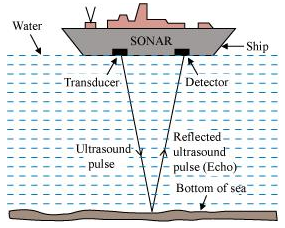
A sonar device on a submarine sends out a signal and receives an echo 5 s later. Calculate the speed of sound in water if the distance of the object from the submarine is 3625 m.
Time (t) taken to hear the echo = 5 s
Distance (d) of an object from submarine = 3625 m
Total distance travelled by SONAR during reception and transmission in water = 2d
Velocity (v) of sound in water = 2d/t = (2 × 3625) / 5
= 1450 ms-1
Explain how defects in a metal block can be detected using ultrasound.
Defective metal blocks will not allow ultrasound to pass through them and reflect it back. This technique is used in detecting defects in metal blocks. Make a set-up as shown in the figure, with ultrasound being passed through one end and detectors placed on the other end of a metal block. Since the defective part of the metal block does not allow ultrasound to pass through it, it will not be detected by the detector. In this way, defects in metal blocks can be detected with the help of ultrasound.
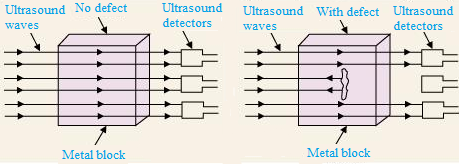
Explain how the human ear works.
Various sounds produced by particles in our surroundings are collected by pinna that transfers these sounds to the eardrum through the ear canal. The eardrum begins to vibrate back and forth briskly as soon as the sound waves fall on it. The vibrating eardrum initiates the small bone hammer to vibrate. These vibrations are passed from the hammer to the third bone stirrup via the second bone anvil. The stirrup strikes the membrane of the oval window to pass its vibration to the cochlea. The liquid in the cochlea produces electrical impulses in the nerve cells. These electrical impulses are carried to the brain by the auditory nerve. They are interpreted by the brain as sound, and hence, we get a sensation of hearing.
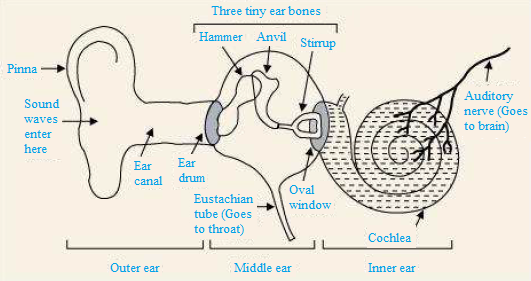
Admissions Open for 2025-26
Frequently Asked Questions
The NCERT solution for Class 9 Chapter 11: Sound is important as it provides a structured approach to learning, ensuring that students develop a strong understanding of foundational concepts early in their academic journey. By mastering these basics, students can build confidence and readiness for tackling more difficult concepts in their further education.
Yes, the NCERT solution for Class 9 Chapter 11: Sound is quite useful for students in preparing for their exams. The solutions are simple, clear, and concise allowing students to understand them better. They can solve the practice questions and exercises that allow them to get exam-ready in no time.
You can get all the NCERT solutions for Class 9 Science Chapter 11 from the official website of the Orchids International School. These solutions are tailored by subject matter experts and are very easy to understand.
Yes, students must practice all the questions provided in the NCERT solution for Class 9 Science Chapter 11: Sound as it will help them gain a comprehensive understanding of the concept, identify their weak areas, and strengthen their preparation.
Students can utilize the NCERT solution for Class 9 Science Chapter 11 effectively by practicing the solutions regularly. Solve the exercises and practice questions given in the solution.

